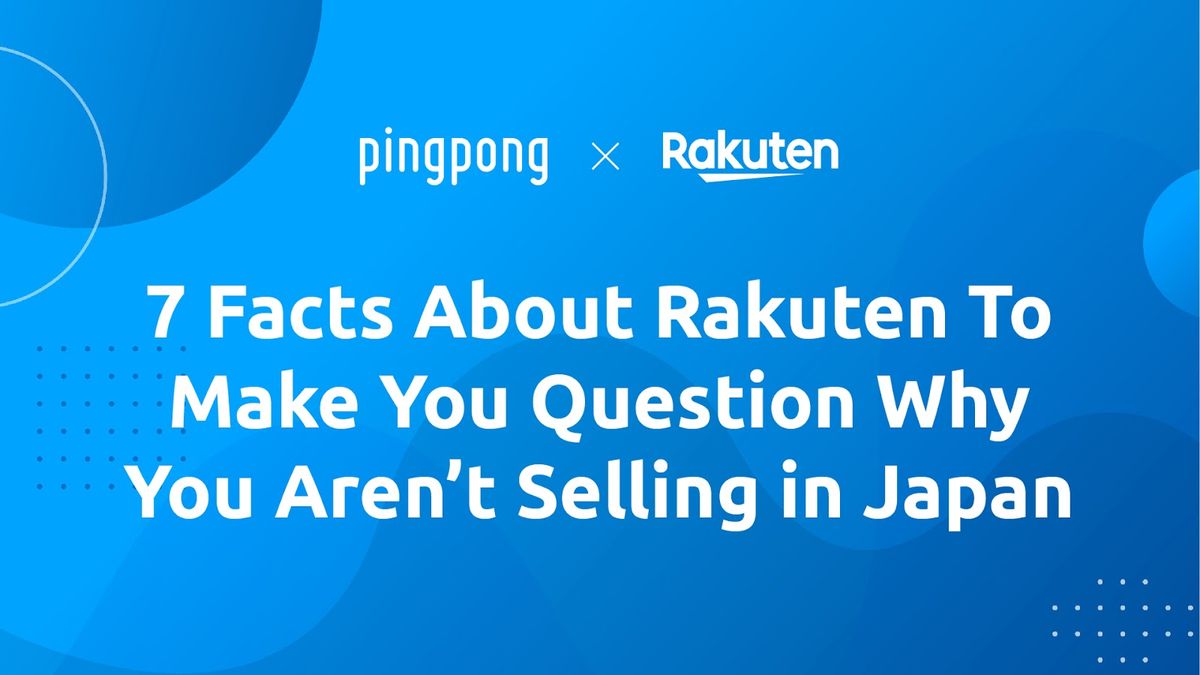First of all, Japan is the world’s third-largest economy and the fourth-largest global eCommerce marketplace.
Furthermore, its population is relatively smaller than that of the world’s leading economies. For merchants, this makes things interesting.
That’s because a whopping ninety-one percent of Japan’s population has internet access - more than the world’s leading economies - and fifty-one percent are on social media (still more than leading economies).
Most importantly, Rakuten itself is larger than Amazon in Japan but isn’t as heavily saturated with merchants - putting revenue growth right at your fingertips.
Here are 8 reasons you should be selling on Rakuten in Japan
1. Rakuten Ichiba is Larger than Amazon Japan
Rakuten dominates the online market in Japan, accounting for 26.8% of the entire eCommerce market share in Japan, and a collective 116.5% in categories such as apparel, food, and household accessories.
This is a pretty big deal. When you rank as the world’s 4th largest eCommerce market and its 3rd largest economy overall - and over 90% of your population uses the internet - your largest eCommerce platform is bound to bring in some income.
2. Number of Sellers on Rakuten
There are less than 50,000 shops on Rakuten. In fact, there is only an 8.7% penetration rate in Japan’s eCommerce market. Why is this a good thing? Because those shops are your competition, and there are fewer on Rakuten. Think about it: there are more than 2.5 million sellers on the Amazon marketplace. Doesn’t make it very difficult to get lost in the sauce.
Bottom line? Japan’s eCommerce penetration rate by merchants is much lower than China’s, the U.K.’s, and the United States.
3. Customer Engagement, Marketing Opportunities + More
Rakuten is like an online mall, made up of all third-party sellers.
Merchants gain access to consumers that allows them to significantly grow brand awareness and maximize sales.
Consumers use Rakuten as entertainment. They aren’t always visiting the platform in search of a key product. Consumers want to browse. This opens the door for merchants to provide customers intimate and customized experiences at every touchpoint. Rakuten customers rely on trends and rankings to make decisions.
Competitively, Rakuten has better user engagement than other marketplaces. Consumers stay on the site longer and on product page views longer than one would on Amazon, for example.
4. Popular Products
Japanese consumers know what they want. These are the products that sell the best in Japan:
- Fashion
- Electronics
- Food/Beverage
- Furniture/Homegoods
- Books
Everyone’s least favorite gamechanger, COVID-19, led to a spike in these categories:
- Food
- Toys & Games
- Sanitary Goods
- Cosmetics
- Furniture
- Home appliances
- PC & Accessories
On the Rise: Trending Opportunities for Merchants
Cosmetics and pharmaceuticals are products that have recently seen consistent growth in Japan’s digital market. Traditionally, these categories have been dominated by Japanese brands found throughout drug stores in Japan. But as the beauty industry moves online and brands shift to digital strategies, more of Japan’s youth are being reached via social media. Thus, overseas brands and an increase in demand for foreign beauty products are on the rise in Japan.
Supplements in the United States are revered as superior products, especially in the workout-related supplement category. Because of their reputation for performance and high quality, the U.S. dominates the demand for supplements in Japan’s market.
Electronics made in Japan are pricey but are considered exceptional in quality. Japanese consumers will choose Japanese brands when they intend on keeping products for a long time. For products that require frequent upgrades, or that don’t have a long lifespan, Japanese consumers tend to lean on foreign markets to get competitive pricing, performance, and features.
5. Points Incentives Preferred
While other online and eCommerce marketplaces tend to lend heavily on discounts and promotions to influence consumer behavior, Japan doesn’t. Japan has a massive culture obsessed with collecting points while shopping.
Tapping into this incentive can be a powerful and advantageous marketing and CRM tool for building customer loyalty with your brand and for generating revenue growth.
Not to mention, Rakuten accounts for 70% of Japan’s points market, a 2.2 billion dollar market.
6. Japan is a very expensive country
Because Japan is a very expensive country, Japanese consumers expect to pay more for a product than that of other overseas consumers, especially in the US. Overseas merchants selling in Japan gain a profitable opportunity to adjust pricing strategy to cover additional operational costs while still remaining competitive in pricing
7. Unique Characteristics of Japanese Consumers
Naturally, Japanese consumers have characteristics unique to those that might be found in other parts of Asia, the U.K., and the United States. Cultural differences in Japan significantly influence customer behavior, no matter what market you’re in. Japanese customers are:
More risk-averse
Safety and credibility are key factors that influence a Japanese customer’s purchase judgment. The great thing about this? Unlike other marketplaces, as a Rakuten merchant, you gain access to invaluable information and data regarding your customers and can control many aspects of your brand, customer experience, and much more.
Lower Return Rates
From a cultural perspective, Japanese people regard returning products as an inconvenience. The customer often bears the costs of the return as well. To avoid doing so, they will often resell an unwanted before returning it. For you, the merchant, this is great. You avoid fees and other potential obstacles that come with returns in other marketplaces.
Crave the Human Touch
Japanese consumers are accustomed to receiving value and transparency in their shopping experiences. Ultimately, they require it. The more detailed information a merchant provides on a product, brand, and other aspects of an item, the better.
Key Considerations When Expanding To Japan on Rakuten
Here’s the thing: there’s a stellar opportunity with Rakuten to tap into Japan’s large economy and growing eCommerce market. However, if it were easy, everyone would do it. But with every challenge comes with a solution.
These are some of the challenges to keep in mind:
Japanese Entity Status
There are companies and individuals you can hire to help you navigate this, and Rakuten offers a solution to get you up and running.
The Language Barrier
The English fluency level in Japan is low. Customers expect (and are more comfortable) shopping in their native language. If you don’t speak or write Japanese this will directly affect your store operations, listings, and product descriptions. Remember, this is important in Japan. You’ll need to consider hiring a native speaker to optimize your storefront. Options:
- Translation companies abroad
- In-house Japanese Speakers
- Freelancers (some dedicated to Rakuten)
Shipping
There are always options when it comes to fulfilling orders. You can choose to stick with your existing logistics, like USPS, FedEx, and UPS, or localize your shipping efforts to enhance the customer experience. Options:
- Existing logistics:
- Japanese shipping companies
- Bulk import (send your items to a warehouse in Japan and have orders fulfilled locally, much like Amazon FBA).
Payments, Duty, Taxes
PingPong has you covered here. Foreign exchange, taxes and paying invoices to suppliers, vendors and logistics companies can all be done from a single platform, making your life way easier
Laws & Regulations - commercial import regulations, supplements, pharmaceuticals, etc.
Are your products going to incur additional fees based on their category? Just one more thing to consider about selling on Rakuten.
What The Heck Are You Waiting For?
Here’s an overview of what it takes to get started selling on Rakuten:
Rakuten has a team of Onboarding Consultants who specialize in overseas business. They guide you through preparing materials for your company’s screening submission. Once all stages of screening are passed, you can begin creating your store on Rakuten’s marketplace.
Once you gain access Rakuten Merchant Server (RMS), the next step will be to register your items, upload your company’s information, set your return and shipping policy, and create your storefront. A Shop Open Advisor will support you with set up.
Once your store is live, a dedicated E-Commerce Consultant (ECC) will be assigned to further drive sales and maximize your store’s performance to ensure success on Rakuten’s marketplace.
Want to know more about Rakuten? Check them out by clicking here!










